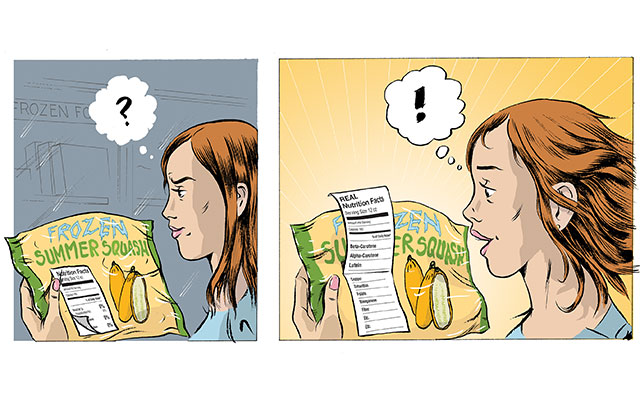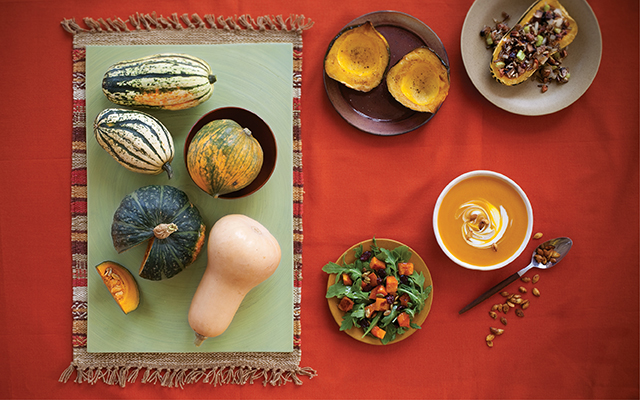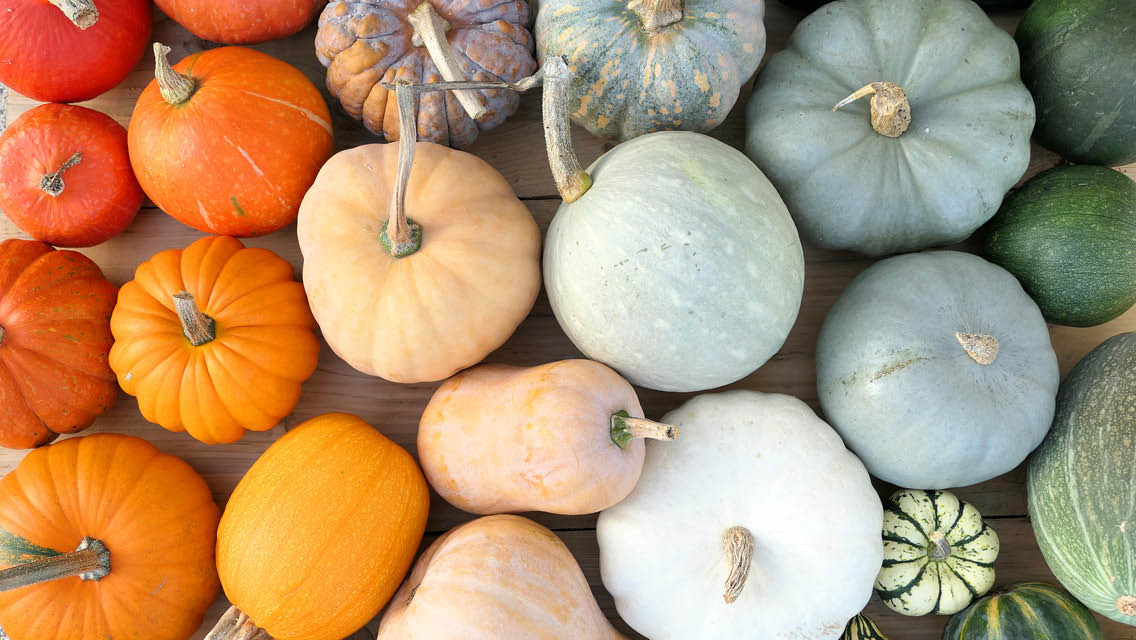Question: What’s the difference between a bag of frozen summer squash and a bag of ice?
Answer: If you were just reading that little black-and-white Nutrition Facts label printed on most every package of food in the United States, you might think, not much.
I’m looking at the so-called facts on a sack of summer squash right now. I have counted 13 zeros.
Calories? Fifteen in one serving. But after that, it’s mostly zeros. Calories from fat, zero. Total fat, zero. Saturated fat, zero. Trans fat, zero. Cholesterol, zero. Sodium, zero percent of your daily value.
Then we bump up a little past zero — but just a little! Total carbohydrate, 1 percent of your daily value. With fiber, we are up to a whopping 3 percent. Protein is less than 1 gram. And then we’re back to a whole lot more nothing: vitamin A, calcium, vitamin C, iron — all zero.
[callout]Given that, could you approximate summer squash by just taking some ice and grating a cheese puff over it?[/callout]So what could a reasonably educated person assume about summer squash except that it’s effectively ice, with a few calories and some fiber?
Given that, could you approximate summer squash by just taking some ice and grating a cheese puff over it? I mean, could you?
No, you could not.
Let me rhapsodize about the hidden treasures inherent in summer squash — qualities that are completely lost by the Nutrition Facts label and that string of zeros.
First, summer squash is mild and sweet and delicious, the bright-yellow kissing cousin of zucchini. But did you ever stop to think about what’s in that edible skin that makes it so colorful? Carotenoids! The phytonutrient that makes carrots orange also makes summer squash yellow.
The veggie’s skin also teems with other phytochemicals — hundreds of compounds that plants produce to help themselves fight off wild diseases and thrive, and which we can use, too.
Summer squash has lutein, which has been shown to help prevent the buildup of plaque in arteries, and zeaxanthin, which fights against macular degeneration by helping the cells in your eyes.
Summer squash is full of alpha-carotene, which helps block cell damage in your body. And it’s stocked with beta-carotene, which converts to vitamin A in the body and helps your eyesight, immune system, skin health, and more.
But wait, there’s more. Summer squash is chock-full of bioavailable copper. In your body, copper is crucial for the functioning of an important antioxidant enzyme, critical for good sleep, and essential for proper blood function.
If you don’t have enough copper, your liver can’t produce hemoglobin, and you could get iron-deficiency anemia, even if you’re eating plenty of iron-rich foods. A single serving of summer squash will give you 21 percent of your daily copper.
It also has plenty of folate — the stuff that’s so important for nerve development that the FDA requires its synthetic form, folic acid, be added to all enriched bread and pasta. And it’s a source of the manganese that your body needs to make collagen, which in turn helps your skin stay stretchy, healthy, and pliable and aids your joints in functioning.
In the book Prescription for Dietary Wellness, Phyllis Balch, CNC, explains that National Institutes of Health researchers have discovered antiviral and anticarcinogenic properties in summer squash that can cut your risk of stomach cancer.
And that’s not all. Summer squash, like all good crunchy vegetables, has lots of fiber, which helps the small, beneficial bacteria that fill your intestines and do amazing things like regulate your weight and help balance your mood.
Folks, is there anything this extraordinary vegetable can’t do?
Well, yes, there is. It can’t get your attention through the nutrition label.
Why? A couple of reasons. One, our labels are captive to some old, outdated concepts about nutrition.
The idea that saturated fats, like those found in butter and eggs, are the reason behind heart disease has been debunked. But our nutrition labels are still obsessed with that fear, and that’s why every single bag of frozen vegetables you can buy is plastered with zeros.
Green beans: zero fat, zero cholesterol, zero trans fat. Broccoli: zeros. Green peas: zeros.
Yet green beans are full of absorbable silicon for bone health. Broccoli has glucosinolates, phytonutrients that help the body detoxify itself. Even the humble green pea is a nutritional powerhouse, boasting strong levels of the anticancer compound coumestrol and dozens of other good things besides.
So how come all the good news about these vegetables is hidden from nutrition labels?
I cynically suspect it’s because no one owns veggies. If one of the food giants had full proprietary rights to summer squash, I bet you we’d have billboards all over town trumpeting the virtues of that bright-yellow fellow.
But just because our nutrition labels are letting us down and yellow squash doesn’t have a dime to market itself, I’m not going to let that stop me. Here’s what I vow: I will speak up for summer squash!
I’ll speak for it, fresh or frozen — those bags of frozen summer squash sitting all lonely in the grocery store, bearing labels that make it seem like weird yellow ice.
I speak for summer squash.
And maybe now you will, too?
Summer Squash Anytime
Fresh summer squash is available in many markets year-round, and it’s easy to find it frozen, too. My favorite way to eat it is cooked with browned garlic and onions. Prepared this way, it’s a great substitute for pasta or polenta in any Italian-accented recipe.
Fresh summer squash can be cut into ribbons using a vegetable peeler and made into a simple salad with a dressing of olive oil, lemon juice, salt, and pepper, and topped with curls of Parmesan cheese, also cut with the peeler.
Sautéed Summer Squash
Eat this squash solo, as a side dish, or in place of pasta with toppings such as grilled sausage or shavings of Parmesan cheese. You might also sprinkle sliced cherry tomatoes on top.
Makes four servings
Preparation time: 20 minutes
- 1 medium onion, sliced
- 1 tbs. butter, coconut oil, or olive oil, or a slice or two of minced bacon
- 1 to 3 cloves of garlic, thinly sliced
- 1 10-ounce bag of frozen summer squash (or enough fresh summer squash, cut into big bite-sized pieces — which will shrink to bite-sized while cooking — to make 3 cups)
- Salt and pepper to taste
Sauté the onion in a frying pan over medium heat with the butter until the onion starts to brown. Add the garlic and cook for a minute until it softens. Add the squash, place a lid on the pan, and cook until the squash is nicely soft. Serve and savor.



This Post Has 0 Comments